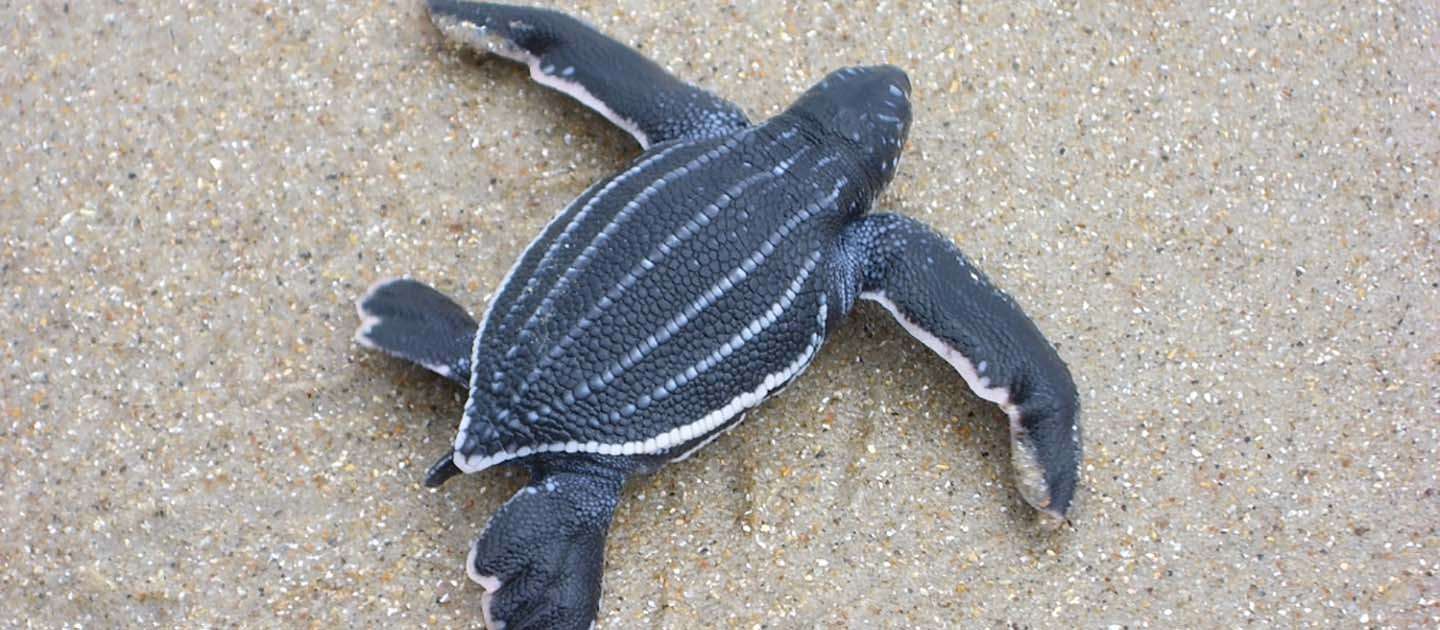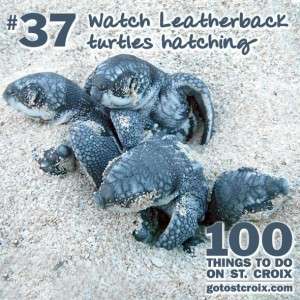Respect the Leatherback Sea Turtles
While many people have a huge fondness and respect for sea turtles, there is something particularly awe inspiring about Leatherback sea turtles. The oldest of all sea turtle species, it has been around for more than 150 million years!
Leatherbacks are also the largest of the sea turtles (and the fourth largest living reptile on Earth) with an average length of 4 to 9 feet and an average adult weight of 660 to 1,100 pounds. The largest Leatherback ever recorded was 10 feet long, and weighed in at a whopping 2,019 pounds! The Leatherback is the only sea turtle that does not have a hard shell. Instead, it has a large, elongated and flexible carapace with 7 distinct ridges running down the length of the turtle. Composed of a layer of thin, tough, rubbery skin strengthened by thousands of tiny bone plates, the flexibility of the carapace allows the Leatherback’s lungs to expand when diving in search of food. In fact, the Leatherback can dive up to 3,000 feet deep!

My family and I had a rare and amazing opportunity to observe the emergence of some Leatherback turtle hatchlings right here on St. Croix. The observation was led by a U.S. Fish and Wildlife employee, Laura, at the Sandy Point National Refuge. Our group met at the entrance to Sandy Point at 5:15pm and drove the main beach, where we parked and walked the short path to the beach. We were instructed to sit and wait patiently while Laura walked the beach to search some 100 nests looking for baby turtle noses peaking out of the sand. How cute is that? So, we waited patiently and discussed what a beautiful, calm but breezy night it was at Sandy Point. The sunset was breathtaking in shades of deep pinks and blues. Heck, we were on the beach, so the kids kept themselves entertained.

After a short wait, Laura retrieved us, put us in two lines and walked us carefully down the beach where she located some turtles emerging from the sand. She was very diligent in making sure no other nests were disturbed during any of this process. We sat in a semicircle around the nest while she explained the entire, fascinating process. This is when I learned a very valid reason why they ask that you not take photos, the flash photography can disorient the endangered species. More importantly, it is tedious and delicate process that should be observed, not something your average Joe should try to do. Volunteers dedicate massive amounts of time (and sleepless nights) to observe, tag and protect female turtles laying their eggs. They then tirelessly return to observe and assist the hatchlings, all the while collecting very important data on these intriguing animals. I totally respect what these volunteers are doing and would not want to encourage anyone to try this on their own.
If you are not familiar with the nesting process of these magnificent turtles, it is really quite amazing. Female Leatherbacks come ashore at night, alone, most often during high tide. After crawling above the high tide line they will dig out a ‘body pit’ using their massive front flippers. Then, using their hind flippers, they dig an egg cavity (the depth of which is determined by the length of the outstretched hind flipper). The females then deposit an average of 80 billiard ball sized fertilized eggs, as well as 30 smaller, unfertilized eggs into the egg cavity. The eggs are soft-shelled, and are a leathery texture, which keeps them from breaking as they fall into the egg cavity. After the eggs are laid, the females then covers the nest with sand using their hind flippers. Burying the eggs serves several purposes: it helps protect them from surface predators; it helps keep the soft, porous shells moist; and, it helps the eggs maintain proper temperature.

Before returning to the ocean, the female Leatherbacks will disturb the sand in the surrounding area using their long front flippers in order to ‘hide’ the nest from predators. The nesting process takes two or more hours out of the water, and each female may nest between 4 and 7 times per season, with about 10 days between nestings…no wonder each female takes 2 to 3 years off between nestings!
The Leatherback turtle eggs will incubate for 65 days before the adorable little hatchlings dig their way to the surface, burst through the sand and make their way down the beach to the sea. As we watched this amazing process in action my 19 month old stood still, awestruck by the ‘tut-tles’; and, my mother was chosen to release one of the hatchlings back into the water. How exciting is that? Especially when you consider that only one in a 1,000 survives to maturity to lay eggs. Let’s hope it was hers.

Leatherback Turtle Conservation and Awareness
The biggest threats to the Leatherback population are marine pollution and bycatch by the fishing industry. Why is marine pollution such an issue for these turtles? Oddly enough, with delicate, scissor-like jaws these enormous turtles feed almost exclusively on jellyfish. However, plastic bags or balloons floating in the water are easily mistaken by the turtles for jellyfish, but can kill them if ingested.
So, what is being done to protect the Leatherback population? Many global conservation organizations are working with fisherman and fisheries to switch to more turtle-friendly fishing hooks (called ‘circle hooks’) and promote the use of devices that exclude turtles from fishing nets. Here on St. Croix, entities such as the U.S. Fish and Wildlife Service, Geographic Consulting, Earth Watch, and more have been (and continue to) patrol the beaches during nesting season, and monitor the turtles that come to nest on our shores and collect as much scientific data as possible. The U.S. Fish and Wildlife Service has run the sea turtle monitoring program at Sandy Point National Wildlife Refuge since 1982, and contracted Geographic Consulting in 2011 to handle the program. The main purpose of the program has been tagging and monitoring the federally endangered Leatherback sea turtle, although other sea turtle species have also been tagged and monitored. Additionally, St. Croix has multiple protected marine areas to ensure safe nesting places for these endangered creatures. In fact, Sandy Point National Refuge is closed to the public from April through August for nesting and hatching season, except by educational observation tours.

Leatherback sea turtle nesting at Sandy Point
On an individual level, you can help the turtles by doing your part to reduce marine pollution. First and foremost, make sure you always properly dispose of your trash. Even better, do what you can to reduce the amount of trash you produce by reusing what you can, and by utilizing reusable containers in-lieu of plastic bags whenever possible. Also, if you come across trash floating in the water or on the beach (especially it happens to be a plastic bag), please pick it up and dispose of it properly to ensure it does not end up harming our marine life. It is up to all of us to do our part!
Most importantly, especially in the spring and summer months, please be aware that most of St. Croix’s beaches are nesting grounds for sea turtles. If you happen to come across a nest, a nesting turtle, or emerging hatchlings, here are some simple rules to follow:
- After dark, do not walk on the beach with a flashlight or shine a light in the sea turtle’s face. The light may cause the female to abort the nesting process, or other sea turtles nearby may be discouraged from nesting if there are lights on the beach. The lights can also disorient hatchlings on the way to the water.
- Do not take pictures using flashes. This high-intensity light can be even more disturbing than the flashlights.
- Stay clear and out of sight of the turtle until she begins laying eggs, otherwise you may scare her back into the sea.
- For your safety, stay away from the turtle’s head. Sea turtles, have very strong jaws and can harm you if provoked.
- Do not allow your dogs to dig on nesting beaches as they may injure the nest, or even eat the eggs.
- Do not disturb a nest, handle the eggs, or put any foreign objects into the nest. You can introduce bacteria or injure the eggs.
- Do not touch or handle the sea turtle or hatchling. In addition to being illegal, you may injure the turtle, cause a nesting turtle to leave without finishing her nest, or keep a hatchling from finding the ocean on their own (which imprints on them for future nesting when they mature).
- Do not disturb tracks left by turtles. Researchers sometimes use the tracks to identify the type of turtles that nested and to find and mark the nests.
- DO enjoy the experience, and remember it for the rest of your life.
 St. Croix Now a National Heritage Area
St. Croix Now a National Heritage Area Interactive Learning at the STXEEMP Visitor Center
Interactive Learning at the STXEEMP Visitor Center Jewelry Collections for a Cause
Jewelry Collections for a Cause Chasing Coral on St. Croix
Chasing Coral on St. Croix Protecting Our Coral Reefs
Protecting Our Coral Reefs Respect the Leatherback Sea Turtles
Respect the Leatherback Sea Turtles Hawksbill Turtle Watch
Hawksbill Turtle Watch St. Croix’s East End Marine Park
St. Croix’s East End Marine Park Birding at Southgate Coastal Reserve
Birding at Southgate Coastal Reserve Volunteer or Donate!
Volunteer or Donate!


